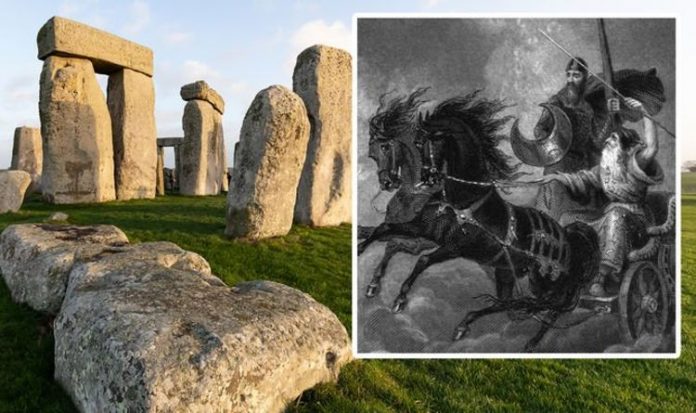Archaeologists believe a dismantled stone circle in west Wales is likely to have been used as the original building blocks for Stonehenge. Excavations and analysis of the site at Waun Mawn, in the Preseli Hills, dated the stone circle to around 3400BC, making it the oldest found in Britain. They believe the stones could have been dismantled in Wales and rebuilt 150 miles away at the site now seen today in Salisbury, Wiltshire.
Several of the monoliths are of the same rock type and one of the bluestones at Stonehenge has an unusual cross-section which matches one of the holes left at Waun Mawn.
The investigation was part of the ‘Stones of Stonehenge’ research project, led by Professor Mike Parker Pearson of University College London, and his discovery was made while filming for BBC Two’s ‘Stonehenge: The Lost Circle Revealed’.
The monument’s mysterious past has spawned countless tales and theories, but according to a legend first recorded 900 years ago, the wizard Merlin led men to Ireland to capture a magical stone circle called the Giants’ Dance.
Geoffrey of Monmouth’s tale states that he then had it rebuilt in England as a memorial to the dead.
His account has been dismissed, partly because he was wrong on other historical facts, but the new breakthrough suggests the bluestones of the monument came from a region of Wales that was considered Irish territory in his day.
But Prof Parker Pearson believes the new discovery “raises the possibility that a 900-year-old legend about Stonehenge being built from an earlier stone circle contains a grain of truth”.
Experts now theorise that Stonehenge was transported by the Neolithic civilisation to become Britain’s first “monument to unification” in 3000BC.
Radiocarbon dating previously suggested the structure was “second hand” and its smaller bluestones stood for four centuries in another location after being quarried in South Wales.
While it is unlikely to have been Merlin who moved the stones, the new discovery raises the credibility that they were transported from Wales and served as the foundation of the monument.
READ MORE: Stonehenge discovery ‘like nothing seen before’ fueled new theory for ancient site
It also confirms that the region was an important and densely settled area in Neolithic times until it appears to have ceased in 3000BC.
DNA and archaeological evidence suggests Waun Mawn’s Neolithic population suddenly “vanished” in a migration from what is now Wales into southern England.
Prof Parker Pearson said: “It’s as if they just vanished. Maybe most of the people migrated, taking their stones – their ancestral identities – with them.”
With only a few of the Stonehenge stones directly linked to Waun Mawn, the archaeologist believes monoliths from other stone circles could have been taken from Wales to form part of the new monument.
Prof Parker Pearson said: “With an estimated 80 bluestones put up on Salisbury Plain at Stonehenge and nearby Bluestonehenge, my guess is that Waun Mawn was not the only stone circle that contributed to Stonehenge.
“Maybe there are more in Preseli waiting to be found. Who knows? Someone will be lucky enough to find them.”
You can watch ‘Stonehenge: The Lost Circle Revealed’ on BBC Two at 9pm tonight.







